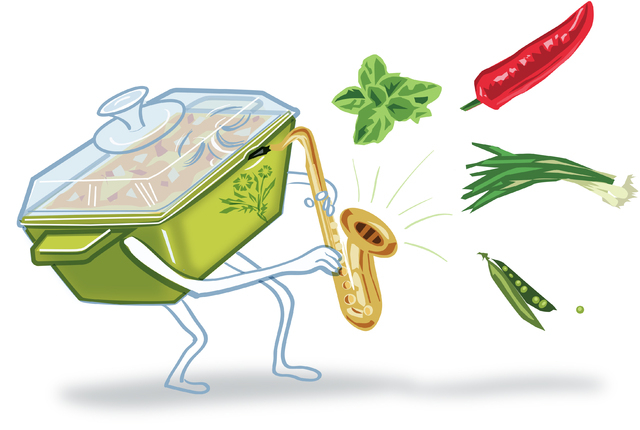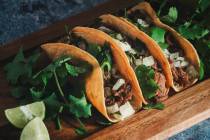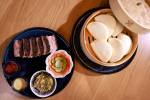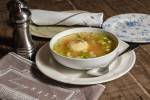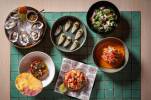Get creative with casseroles
When Richard Holland became room chef at Texas Station’s Feast Buffet about two years ago, he started thinking about improvements to a traditional Southern ham and hominy dish, which he says is “basically a brothy dish, kind of like collard greens.” His idea was to turn it into a casserole.
“I wanted to add some different layers and textures and add some eye appeal,” Holland said. “I added sour cream to give it more of a hearty taste, and more of a filler, because I have to balance costs as well as flavors. I also added diced green chilis to incorporate an additional level of flavor, and Oaxacan jack cheese, cheddar cheese and Parmesan for a bit more depth. You get a really well-rounded meal.”
At first, Holland wasn’t sure how buffet guests would receive the dish. He tried walking around and looking for signs of uncertainty: “Just get a small bowl and give it a shot and I’ll come visit you halfway through your meal and see what you think.” It didn’t take long before the casserole was a hit at Texas Station. And now it’s getting more exposure.
“We just rolled out a new barbecue menu for all of the Station Casinos, and added it to all the buffets,” with corn as an added ingredient, Holland said. And he isn’t really surprised, because he understands the appeal of casseroles — and why, sometimes, a little reinvention is a wonderful thing.
“Casseroles are kind of an unseen type of recipe,” he said. “They don’t get used quite enough.”
Which is where the reinvention comes in.
“You can basically turn just about anything into a casserole,” Holland said. “You want to keep the original recipe flavor profile initially, but you want to give it more layers; like an onion, you want to get more and more the deeper you get.”
An example, Holland said, is to start with the basic love-it-or-hate-it green-bean casserole.
“You throw some bacon in there and you throw some chicken in there and you have a whole other thing,” he said.
Daniel Boling, executive chef at Made L.V. in Tivoli Village, said he comes by his appreciation of casseroles honestly.
“I’m actually from Michigan,” Boling said. “I ate a fair amount of casseroles in Michigan. That was a pretty staple thing.”
Which means, surely, that he’s eaten his share of green-bean casserole, and he’s developed his own take on it.
“Instead of just mushroom soup and frozen green beans, use the best possible products,” Boling said. “Use fresh green beans and make your own mushroom soup with roasted mushrooms. Add some truffles in there. They lend themselves nicely, even if it’s canned black truffle or some truffle oil on top. Shave an onion or shallot, marinate them in a little buttermilk, dip them in seasoned flour and pan-fry them” for the topping.
Boling also grew up with tuna-noodle casserole, and said he actually had it on the menu when he worked at a restaurant in California. He suggests making it with fresh tuna, giving the fish a confit treatment by heating olive oil with herbs and garlic and pouring it over the tuna, then cooling and refrigerating. Or he suggests using grilled tuna, maybe seasoned with a rub.
“Use a nicer noodle,” Boling said. “Use an egg noodle, or make your pasta from scratch. Make a bechamel sauce with roux. Use fresh peas if they’re in season. I love doing fresh fried potato chips on top.”
Before serving, Boling tops it with a simple salad of Italian parsley, arugula, green onion and basil, tossed with some lemon juice and olive oil and seasoned with salt and pepper.
“Put that over the casserole as you’re serving it,” he said. “It looks a heck of a lot better, and it takes a dish that’s extremely heavy and lightens it up.”
Tim Doolittle, chef de cuisine at Table 10 at the Palazzo, said he thinks pan selection is the most important thing when preparing a casserole.
“I’m sure we’ve all had a lasagna, or something like that, with crusty edges and burned bits on the bottom,” he said. “There’s a fine line there; sometimes that can be good — what you’re looking for, the best part of the casserole — other times it can be what ruins it.”
Most ovens heat from the bottom, Doolittle said. If you use a thin metal pan, the bottom part will be overcooked before the top is cooked. With a heavier pan, he said, you get a more even, gentle heat.
“The Pyrex and glass is fine,” he said. “Porcelain looks nice on the table and works well; we use it a lot in professional kitchens. If I was going to buy something for forever, it would be enameled cast iron.
“It’s a good cooking method. Casserole-like side dishes are great. Everybody likes gratineed potatoes.”
And if you up your casserole game just a bit, you’ll surprise family and friends.
“I love to implement casseroles in my menu,” Boling said, “just because that’s one of the things people don’t think can be upscale or classy.”
BEEF TERIYAKI CASSEROLE
Salt
1 pound green beans, trimmed and cut into 1-inch lengths
3 medium red bell peppers, stemmed, seeded, and sliced into ¼-inch-thick strips
1½ cups long grain white rice
4 pounds sirloin steak tips, cut into 1-inch chunks
3 tablespoons vegetable oil (divided use)
¾ cup soy sauce
1½ cups mirin
6 tablespoons sugar
2 tablespoons cornstarch
1 4-inch piece of fresh ginger, peeled and grated fine
6 medium garlic cloves, minced or pressed through a garlic press
6 scallions, white and light green parts minced and dark green parts sliced thin
1 tablespoon sesame seeds, toasted in a dry skillet over medium heat until golden and fragrant, about 7 minutes
Adjust an oven rack to the middle position and heat the oven to 450 degrees. Bring 4 quarts of water to a boil in a large pot (with a perforated pasta insert, if available) over high heat. Add 1 tablespoon salt, the beans and peppers; cook until the vegetables are brightly colored and slightly crunchy, about 1 minute. Remove the vegetables from the boiling water with a slotted spoon (or by lifting out the pasta insert, if using) and spread out over a paper-towel-lined baking sheet to drain and cool. Return the water to a boil and add the rice; cook until almost tender but still firm to the bite, about 12 minutes. Drain thoroughly.
Meanwhile, thoroughly pat the meat dry with paper towels. Heat 1 tablespoon of the oil in a 12-inch nonstick skillet over medium-high heat until just smoking. Distribute half of the meat evenly in the skillet and cook, without stirring, until well browned on one side, about 4 minutes. Transfer the meat to a clean plate; set aside. Add 1 more tablespoon oil to the skillet and return to medium-high heat until just smoking; brown the remaining meat and transfer it to the plate.
Whisk the soy sauce, mirin, sugar and cornstarch together until the sugar has dissolved; set aside. Add the remaining tablespoon oil to the skillet and return to medium heat until shimmering. Add the ginger, garlic and minced scallions; cook until fragrant, about 30 seconds. Briefly re-whisk the soy mixture and add it to the skillet. Bring to a simmer and cook until thickened, 1 to 2 minutes. Off the heat, add the browned meat and toss to coat.
Spread the rice in a 9-by-13-inch baking dish (or a shallow casserole dish of similar size). Spread the cooked beans and red peppers over the rice. Spread the beef evenly over the vegetables and sprinkle with the sesame seeds. Bake until the beef looks dark and glossy, 15 to 20 minutes. Sprinkle with the sliced scallion greens. Serve immediately.
Serves 8 to 10.
— Recipe from America’s Test Kitchen
MEDITERRANEAN-STYLE SHRIMP ND ORZO CASSEROLE
1½ pounds large shrimp (31 to 40 count), peeled and deveined
Salt and ground black pepper
3 tablespoons extra-virgin olive oil
1 medium red onion, minced
1 large red bell pepper, stemmed, seeded and chopped fine
6 medium garlic cloves, minced or pressed through a garlic press
1 pound orzo
1 large pinch saffron
1 tablespoon lemon zest and 2 tablespoons lemon juice
4 cups low-sodium chicken broth
1 cup water
1 (28-ounce) can diced tomatoes, drained
4 teaspoons chopped fresh oregano leaves
12 ounces feta cheese, crumbled into large pieces (about 3 cups)
4 scallions, white and light green parts only, sliced thin
Adjust an oven rack to the middle position and heat the oven to 400 degrees. Season the shrimp generously with salt and pepper; set aside.
Heat the oil in a 12-inch skillet over medium heat until shimmering. Add the onion, pepper and ½ teaspoon salt; cook, stirring occasionally, until the vegetables are softened and beginning to brown, about 6 minutes. Add the garlic and cook until fragrant, 30 seconds. Add the orzo, saffron and lemon zest; cook, stirring frequently, until the orzo is coated with oil and lightly browned, about 4 minutes. Stir in the broth and water; cook, stirring occasionally, until the grains of orzo are mostly tender yet still slightly firm at the center, about 12 minutes. Stir in the tomatoes, oregano and seasoned shrimp.
Pour into a 9-by-13-inch baking dish (or a shallow casserole dish of similar size). Sprinkle the feta over the top and bake until the shrimp are cooked through and the cheese is lightly browned, about 20 minutes. Sprinkle with the lemon juice and garnish with the scallions. Serve immediately.
Serves 6 to 8.
— Recipe from America’s Test Kitchen
TUNA NOODLE CASSEROLE
1 medium onion, finely chopped
4½ tablespoons unsalted butter
10 ounces mushrooms, trimmed and sliced ¼ inch thick (4 cups)
2 teaspoons soy sauce
¼ cup sherry
¼ cup all-purpose flour
2 cups low-sodium chicken broth
1 cup whole milk
2 teaspoons fresh lemon juice
¼ teaspoon salt
1 6-ounce can tuna in olive oil, drained
6 ounces dried curly egg noodles (preferably Pennsylvania Dutch style; about 3¼ cups)
1½ cups coarse fresh bread crumbs (from 3 slices firm white sandwich bread)
4 ounces coarsely grated Cheddar (1 cup)
1 tablespoon vegetable oil
Put oven rack in middle position and preheat oven to 375 degrees. Butter a shallow 2-quart baking dish.
Cook onion in 1½ tablespoons butter with a pinch of salt in a 12-inch heavy skillet over moderately low heat, covered, stirring occasionally, until softened, about 5 minutes. Increase heat to moderately high and add mushrooms, then saute, stirring occasionally, until mushrooms begin to give off liquid, about 2 minutes. Add soy sauce and continue to saute mushrooms, stirring, until liquid mushrooms give off is evaporated. Add sherry and boil, stirring occasionally, until evaporated. Remove from heat.
Melt remaining 3 tablespoons butter in a 2- to 3-quart heavy saucepan over moderately low heat and whisk in flour, then cook roux, whisking, 3 minutes. Add broth in a stream, whisking, and bring to a boil, whisking. Whisk in milk and simmer sauce, whisking occasionally, 5 minutes. Stir in mushroom mixture, lemon juice and salt. Flake tuna into sauce and stir gently. Season sauce with salt and pepper.
Cook noodles in a 5- to 6-quart pot of boiling salted water until al dente. Drain noodles in a colander and return to pot. Add sauce and stir gently to combine. Transfer mixture to baking dish, spreading evenly.
Toss together bread crumbs and cheese in a bowl. Drizzle with oil and toss again, then sprinkle evenly over casserole. Bake until topping is crisp and sauce is bubbling, 20 to 30 minutes.
Serves 4 to 6.
— Recipe from Gourmet
POTATO AND BLACK BEAN CASSEROLE
Oil for baking dish
¾ cup chopped fresh cilantro (divided use)
2 4-ounce cans diced green chilies, drained
¼ cup canned salsa verde (tomatillo salsa)
3 large garlic cloves, minced
1½ teaspoons ground cumin
1 16-ounce purchased polenta roll, cut into 18 rounds
½ cup whipping cream
1 15-ounce can black beans, well drained
1 15-ounce can golden hominy, well drained
3 cups coarsely grated Monterey Jack cheese (about 10 ounces)
Position rack in middle of oven and preheat to 450 degrees. Oil an 11-by-7-by-2-inch glass baking dish.
Mix ½ cup cilantro, chilies, salsa verde, garlic and cumin in medium bowl. Arrange nine polenta rounds in bottom of dish, spacing evenly. Drizzle ¼ cup cream over. Top with half of beans, half of hominy and half of chili mixture. Sprinkle with 1½ cups cheese. Repeat layering. Cover with foil.
Bake 20 minutes. Increase oven temperature to 475 degrees, uncover casserole and bake until top is golden brown, about 15 minutes longer. Let stand 5 minutes; sprinkle with remaining ¼ cup cilantro and serve.
Serves 6.
— Recipe from Bon Appetit
Contact reporter Heidi Knapp Rinella at hrinella@reviewjournal.com or 702-383-0474.


